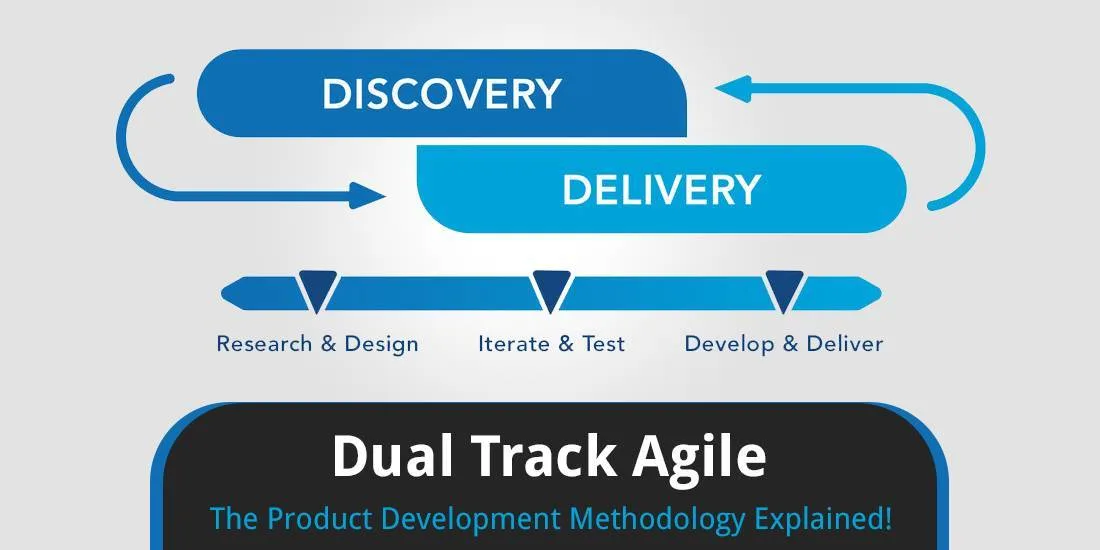Dual Track Agile: The Product Development Methodology Explained!

Introduction
Businesses get overwhelmed with product development. Right from developing a product that adds value to the users to finally marketing it successfully seems to be a tiring task. Most of the time Agile or Waterfall methodology is followed by the product development company. The waterfall methodology consists of different phases which include requirement analysis, designing, implementation, and coding. This methodology is linear and progressive in fashion and is expensive in nature. In case any changes are to be made in design or coding, then the team has to again go to the analysis and design phase. This way, a lot of money and time is consumed to develop a product.
This is where Agile methodology seems to be a boon. Dual-track agile is a kind of agile development methodology which comprises of two tracks: the Discovery and the Delivery. Choosing dual-track agile has its own benefits in product development.
So, without wasting any more time, let’s see what dual-track agile all about!
What is dual-track agile in terms of software development?
Even when you are following the best process for product development you will find that agile development and the process of designing the UX does not go together well enough. In order to resolve these issues, developers now opt for Dual-track agile. Here it follows two simultaneously running tracks to speed up the development and delivery process. The two different tracks followed in here are – “Discovery” track and the “Delivery” track.
The product ideas get built, tested, and validated in the discovery track. On the other hand, such ideas get turned into real products in the delivery track. It can be said that the dual-track agile brings together UX design and agile development together under a single roof without any issues and thus develop amazing products.
In short, the product development teams can carry out research and development in parallel by opting for dual-track agile.
Origin of dual-track agile
Dual-track agile is said to have its roots in 2005, a few years after agile manifesto was released and accepted by the crowd.
The director of User Interface Development at Alias, Lynn Miller came with an idea in her paper where she mentioned about parallel working design and development tracks that are interconnected. She did not give it a name then.
It was then in 2012 the idea about “dual-track scrum ” was brought to light by Jeff Patton and Marty Cagan. The idea spoke about discovery and delivery tracks. Here the inputs for delivery were the outputs from discovery. What needs to be build was decided by discovery while how to build was decided in delivery. This was the beginning of dual-track agile!
Why go for dual-track agile?
The main purpose of going for agile development is to go through multiple iterations quickly so that you can continuously improve the product, thereby offering better value to the users. Even if can build products quickly and make new releases there can still be some gaps between the iterations. With dual-track agile, you will be able to easily fill in those gaps using user-centric design and research.
Generally, product managers decide the next stage in product development based on collected user feedback. Many a time, such feedbacks are not clear or are even lost. There are instances where the user is not clear about what they want or how to explain things. This means the product managers need to spend more time and money to get insights from such feedbacks and the majority of the time; they don’t have it to invest. As a result, product managers end up assuming things and this leads to wrong developments in product.
However, waiting for user feedback can be frustrating and expensive. This is where a better solution like dual-track agile works!
Dual-track agile Process for product development

1. The Discovery Track
This is also called as discovery cycle and it is all about coming up with a faster version of product backlog items that have been validated by the combined efforts of engineers and designers, which can then be used in the delivery track.
So just as the name suggests, in this phase all the work related to gathering information is carried out. So based on the collected information and by talking to the users, the product requirements are figured out.
Some of the tasks carried out in this track are as follow:
Interview of stakeholders
First things first, know your stakeholders. Stakeholders are an individual or an organization that can affect your organization or can get affected by it. The team involved in the discovery track needs to conduct interviews with the owners of the organization and learn more about the policies and vision. Such information will help to decide how product development will take off.
Research of users
The product or the software you are developing is done targeting a specific user base. For the same reason, it would be wise to understand them right from the starting of the dual track process of product development. You can go with different methodologies followed for user research like conducting surveys, interviews, demographic studies, etc.
It is always recommended to go ahead with interviews as you will be able to interact with the users directly and easily connect with them. You may not find specific users for digital startups and it can be wise to reach out to the users of their competitors. You should focus on their problems during the research and should come up with the features that they are looking for.
Developing scenarios and personas
Once you have done your part of the research, you can start building the personas. In case you are planning to go in-depth with the user stories then it can seem to be much useful to you. This way you will end up developing patterns that may seem useful to you during the further phases in product development.
Things work in a similar fashion when it comes to creating scenarios. This can include discussing some user scenarios about accomplishing a said task and the issues they encountered while getting it done. You also need to discuss the ways they took to resolve the issue and get the work done.
Story mapping
It is very important to prioritize tasks in agile. Based on what you have learned from your research, you need to prioritize the things in a clear order. You should take the time to go through user stories that you have collected as a part of story mapping. This will help you prioritize the features in there. This can work well in scenarios where you plan to have in a list of features added to your project. This way you will be able to distinguish the major ones compared to the ones that are of lesser value.
2. The Development Track
Based on the product backlog items that have been defined and validated in the previous track, here the software is developed. The product developed in the Discovery track may be released too.
Once all the user research is completed in the Discovery track, the next thing to do is to go ahead with the product design. Before going ahead with that the team needs to be clear about what they will be delivering and how it will be done. Once that has been decided, the team can proceed ahead with the different tasks to be completed here.
Creating a rapid prototype
When it comes to digital startups their main concern is to complete the development at the earliest and bring it to market fast. However, it is always recommended to come up with prototypes first and test it. Rapid Iterative Testing and Evaluation (RITE) is one of the effective methods which can be carried out effectively.
Informal and iterative testing
Throughout the Delivery track, the user feedbacks are collected and it is not limited to the release of the final product. It becomes easy for the delivery team to find and resolve the issues at the earliest by involving the users. This will save them later from having to go through the trouble of conducting major work after the development is completed.
When the development team, managers, and users –all are involved in the development phase, the team will know the users well and will have a clear about what they want.
Improving user interface
This step is about customer feedback and user research inputs. Even after the prototype is developed, the developers and designers keep on working on the product. This is the step taken to make improvements. So having a better understanding of the users help them to improve the interface and thereby offer better user experience.
You need to understand that here in dual-track both the tracks are connected and work in a loop. Here one doesn’t wait for another one to finish, rather they work parallel to each other.
Benefits of dual-track agile
Dual-track agile is where the cross-functional product team breaks its daily development work into two tracks: discovery and delivery.
Leads to less rework
Dual-track agile is all about offering less rework. Just understand that if the backlog items are not properly defined, qualified and validated, then you can expect much rework to be done in the project. The project will slow down and more resources and time will be lost during the rework. Chances are high that deadlines will be missed and even if it happens to be met, chances are more that the result will not be that appealing.
Agile development is all about making iterations and you can expect it to go for more than a couple of cycles. Here the team is expected to go through some iteration for making changes and if you don’t do the things the right way in the first few ones, you will end up making more iteration. This means you will be wasting more time and money which could have been saved otherwise.
If you are conducting meetings again just to get better clarity then this means that you did not do well in the previous meetings. In short, this means you are wasting more resources.
The discovery and delivery tracks will ensure that all the information needed by the members of the product development team will be made available. So the number of iterations will be less and so will be the time and costs spent.
Leads to development of quality products
By having well-defined backlog items, it will become possible for the team to find the features that are of less or no value and remove them. This will help you avoid situations where the users only end up using half of the functionality released in the software.
The validation within the dual-track agile will determine whether there is any need to have in the said feature. While carrying out the discovery and the delivery tracks together, it is possible to keep in check the user experience. This way you will be able to know which features can be good for the users and which ones should be removed. This will help to create a product that is best in quality.
Makes validation less expensive
Many of the product developers often fail to understand one important aspect of development, which is validation. Many feel it to be unnecessary while others fail to understand its importance. To build qualitative products you must validate your ideas. However, many ignore it just because it involves coding, and can be time-consuming and expensive at the same time.
Then there are some developers, who go ahead with it without having full-faith which completely ruins the idea of having it in the first place. For the same reason, developers are trying to make validation of ideas cheaper, faster and manageable. This is where dual-track agile seems to be a winning solution. The discovery team in dual-track agile makes use of prototypes, research, surveys, etc. to validate the ideas. This makes the validation faster and easier without using codes.
Improves user experience
Agile development and user experience design have never gone together seamlessly. For the same reason, it has been difficult for the developers to bring both together under an umbrella. The developers could concentrate only on one thing at a time. They can either focus on user experience or go with product development iterations.
In case of dual-track agile, two different tracks named discovery and delivery are separately created and so each of the teams can concentrate on what they do. The discovery team can learn from user experience and create prototypes while the delivery team can start working on the specifications received from the discovery team.
Helps to cope with change in a better way
One of the important characteristics of businesses is flexibility and everyone can benefit from it. The information technology industry is fast-moving and startup businesses in the digital world can’t cope up with the change and keep moving. They can easily train themselves for the change by implementing a dual-track scrum.
Final thoughts
For digital startups, dual-track agile is considered to be a much-recommended solution. However, you must choose the right people for the teams and come up with a proper schedule. You must stay focused on the project from the beginning itself. Depending on the kind of startup, the business goals, and the scheduling, the dual-track agile may be implemented differently for effectiveness.








